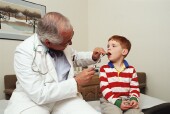- Skip Storing This Everyday Product in the Fridge Door
- Green Tea + B3 Pairing May Boost Brain Health
- Navigating Your Midlife Crisis: Embracing New Possibilities
- City Raccoons Showing Signs of Domestication
- Mapping the Exposome: Science Broadens Focus to Environmental Disease Triggers
- One Week Less on Social Media Linked to Better Mental Health
- Your Brain Changes in Stages as You Age, Study Finds
- Some Suicide Victims Show No Typical Warning Signs, Study Finds
- ByHeart Formula Faces Lawsuits After Babies Sickened With Botulism
- Switch to Vegan Diet Could Cut Your Greenhouse Gas Emissions in Half
Kids Prescribed Antibiotics Twice as Often as Needed, Study Finds


Pediatricians prescribe antibiotics about twice as often as they’re actually needed for children with ear and throat infections, a new study indicates.
More than 11 million antibiotic prescriptions written each year for children and teens may be unnecessary, according to researchers from University of Washington and Seattle Children’s Hospital. This excess antibiotic use not only fails to eradicate children’s viral illnesses, researchers said, but supports the dangerous evolution of bacteria toward antibiotic resistance.
“I think it’s well-known that we prescribers overprescribe antibiotics, and our intent was to put a number on how often we’re doing that,” said study author Dr. Matthew Kronman, an assistant professor of infectious diseases at Seattle Children’s Hospital.
“But as we found out, there’s really been no change in this [situation] over the last decade,” added Kronman. “And we don’t have easily available tools in the real-world setting to discriminate between infections caused by bacteria or viruses.”
The study was published online on Sept. 15 in the journal Pediatrics.
Antibiotics, drugs that kill bacteria or stop them from reproducing, are effective only for bacterial infections, not viruses. But because doctors have few ways of distinguishing between viral or bacterial infections, antibiotics are often a default treatment.
To determine antibiotic prescribing rates, Kronman and his colleagues analyzed a group of English-language studies published between 2000 and 2011 and data on children 18 and younger who were examined in outpatient clinics.
Based on the prevalence of bacteria in ear and throat infections and the introduction of a pneumococcal vaccine that prevents many bacterial infections, the researchers estimated that about 27 percent of U.S. children with infections of the ear, sinus area, throat or upper respiratory tract had illnesses caused by bacteria.
But antibiotics were prescribed for nearly 57 percent of doctors’ visits for these infections, the study found.
“I thought it was really a clever study, actually, to get a sense of the burden of bacterial disease and what the antibiotic usage is,” said Dr. Jason Newland, medical director of patient safety and system reliability, and associate professor of pediatrics at University of Missouri-Kansas City School of Medicine.
Newland, former director of the Antimicrobial Stewardship Program at Children’s Mercy Hospital and Clinics in Kansas City, cited the 2013 “threat report” by the U.S. Centers for Disease Control and Prevention that indicated 23,000 Americans die each year due to antibiotic-resistant infections.
“We all know when we use antibiotics that we increase the chance of resistance because bacteria evolve,” he said. “We need to use them well and not in such excess doses. We have to do way better.”
A rapid strep test is currently available to distinguish between bacterial or viral throat infections. But other than that test, physicians have no other clinical tools to tell the cause of most upper respiratory infections, according to background information in the study. Kronman said he hopes the new research will not only help encourage the development of more such tools, but also spur clinicians to think more critically about prescribing antibiotics unless clearly needed.
Kronman added that prior research indicates that parents — who often pressure pediatricians into prescribing antibiotics — respond to alternate suggestions to alleviate their children’s upper respiratory symptoms, such as using acetaminophen and humidifiers, instead of doctors simply saying they won’t prescribe antibiotics.
“We have to take this [problem] on as a society,” Newland said. “The reality is that the excess, unnecessary use of antibiotics is really putting us at great risk of not having these antibiotics [work] in the future.”
More information
The U.S. National Library of Medicine offers more information about antibiotics.
Source: HealthDay
Copyright © 2025 HealthDay. All rights reserved.










